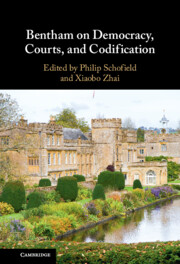Book contents
- Bentham on Democracy, Courts, and Codification
- Bentham on Democracy, Courts, and Codification
- Copyright page
- Contents
- Contributors
- Introduction
- Part I Democracy
- 1 Intellectual Aptitude and the General Interest in Bentham’s Democratic Thought
- 2 Bentham, Democracy, Free Government, and the Relationship between Rulers and Ruled
- 3 The Interests of Women in Bentham’s Late Constitutional Thought
- 4 Religion and Judgement in Bentham’s Political Thought
- 5 Organizing the Utilitarian State
- 6 Bentham on the Corruption of Democracy
- 7 The People’s ‘Greatest Misfortune’ and ‘All the Chance the People Have’
- Part II Law and the Courts
- Part III Codification
- Bibliography
- Index
3 - The Interests of Women in Bentham’s Late Constitutional Thought
from Part I - Democracy
Published online by Cambridge University Press: 25 August 2022
- Bentham on Democracy, Courts, and Codification
- Bentham on Democracy, Courts, and Codification
- Copyright page
- Contents
- Contributors
- Introduction
- Part I Democracy
- 1 Intellectual Aptitude and the General Interest in Bentham’s Democratic Thought
- 2 Bentham, Democracy, Free Government, and the Relationship between Rulers and Ruled
- 3 The Interests of Women in Bentham’s Late Constitutional Thought
- 4 Religion and Judgement in Bentham’s Political Thought
- 5 Organizing the Utilitarian State
- 6 Bentham on the Corruption of Democracy
- 7 The People’s ‘Greatest Misfortune’ and ‘All the Chance the People Have’
- Part II Law and the Courts
- Part III Codification
- Bibliography
- Index
Summary
In Constitutional Code, Volume 1, Bentham proposed ‘virtual universality’ of suffrage, giving the right to vote to ‘the whole body of the inhabitants, who, on the several days respectively appointed for the several Elections … are resident on the territory of the state, deduction made of certain classes’. Among the ‘classes thus deducted’, alongside minors and non-readers, stood ‘[F]emales’.1 Women were thus excluded from the ‘constitutive authority’, the founding authority in the State. Unlike other provisions of the code deemed to require explanation, this ‘enactive’ law was not justified by any corresponding ‘ratiocinative’ text. This cursory exclusion would have passed unnoticed in the context of nineteenth-century dismissals of women’s political rights, had it not contradicted other statements in which Bentham openly justified female suffrage. For instance, as late as 1822, at the time he was working on Constitutional Code, he lamented in manuscripts that ‘the gentler half of the species stand as yet excluded [from the suffrage] by tyranny and prejudice’.2
- Type
- Chapter
- Information
- Bentham on Democracy, Courts, and Codification , pp. 68 - 87Publisher: Cambridge University PressPrint publication year: 2022



